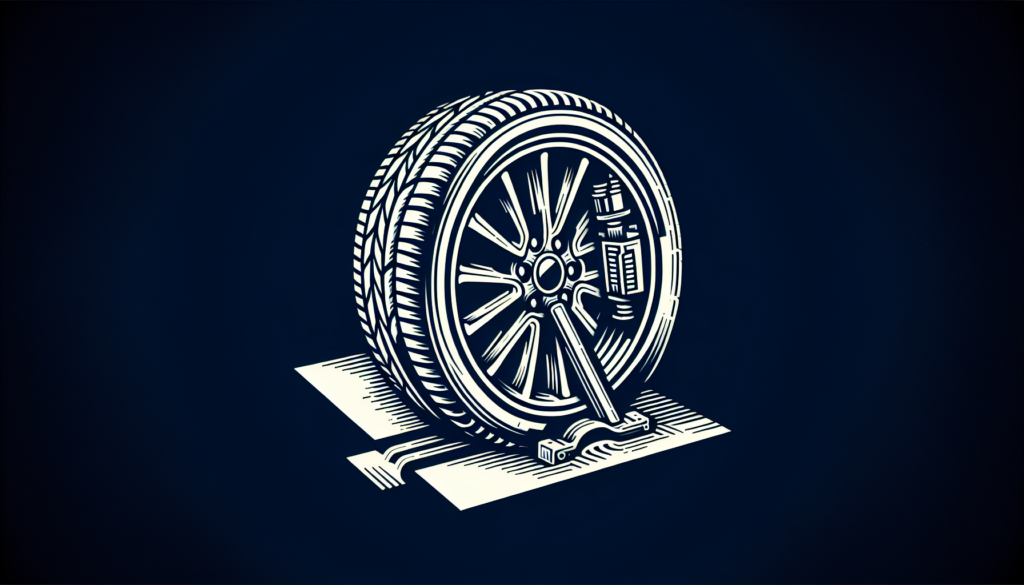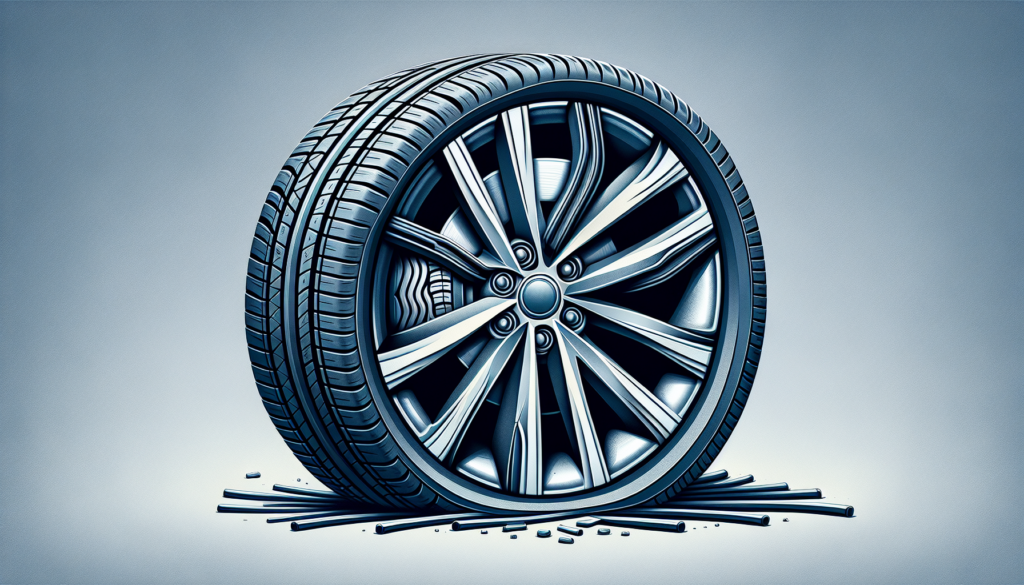Have you ever noticed your car pulling to one side while driving, or felt vibrating or pulling in the steering wheel? These could be signs of misaligned wheels. Misalignment occurs when the angles of your tires are no longer parallel to each other, leading to potential issues with safety, vehicle performance, and tire longevity. In this article, we will explore the common signs that indicate your wheels may be in need of alignment, helping you identify and address this issue before it causes further damage.
Uneven Tire Wear
Cupping or scalloping
Uneven tire wear, such as cupping or scalloping, is a clear indication that your wheels may be misaligned. Cupping refers to the formation of small, uneven depressions on the tire tread, giving it a scalloped appearance. This occurs when the tire bounces as it rolls along the road, causing the tread to wear unevenly. These irregular tread patterns can lead to a noisier and rougher ride quality. If you notice cupping or scalloping on your tires, it’s essential to have your wheel alignment checked and corrected to prevent further damage.
Inner or outer edge wear
Another sign of misaligned wheels is inner or outer edge wear on the tires. Normally, tires wear evenly across their tread, but when your wheels are not properly aligned, the wear pattern becomes skewed. If the inner edges of your tires are wearing faster than the rest of the tread, it suggests that your wheels are angled inward (known as toe-in misalignment). On the other hand, if the outer edges are wearing more rapidly, it indicates that the wheels are angled outward (known as toe-out misalignment). Addressing these misalignment issues promptly can help prolong the lifespan of your tires and ensure optimal performance.
Feathering
Feathering is a tire wear pattern characterized by the tread ribs having a ramp-like shape, resembling the edge of a feather. This occurs when the tires scrub against the road at an angle due to misaligned wheels. The feathered edges can often be felt by running your hand over the tread in one direction, then in the opposite direction. If you notice feathering on your tires, it’s a clear sign that your wheels need realignment. Ignoring this issue can lead to premature tire wear, reduced stability, and compromised handling.
One-sided wear
When your wheels are misaligned, one of the potential consequences is the occurrence of one-sided wear on your tires. This means that the tread on one side of the tire is wearing faster than the other side. It can be observed by comparing the tread depth on both sides of the tire using a tread depth gauge. One-sided wear can be caused by different types of misalignment, including camber misalignment (where the wheel tilts inward or outward), which can result in uneven tire contact with the road surface. Promptly addressing this issue through wheel alignment can help restore balance and prevent further tire wear.
Vehicle Pulling to One Side
Constant veering
If your vehicle tends to pull or veer to one side while driving on a straight road, it’s a clear sign of wheel misalignment. Instead of traveling in a straight line, your vehicle may require constant steering correction to keep it on track. This pulling sensation can be either subtle or pronounced and is often more noticeable when driving at higher speeds. Wheel misalignment causes an uneven distribution of forces on each tire, resulting in an imbalanced steering response. If you experience constant veering, it’s crucial to have your wheels aligned to ensure safer and more stable driving.
Requires steering correction
Another sign of misaligned wheels is the need for excessive steering correction. When your wheels are properly aligned, your vehicle should respond smoothly to your steering inputs without requiring excessive adjustment. However, if you find yourself constantly having to correct the steering to keep your vehicle going straight, it’s a strong indicator of wheel misalignment. This constant need for steering correction not only causes frustration but can also compromise your control over the vehicle. Therefore, it’s important to address this issue promptly through wheel alignment to maintain a safe and comfortable driving experience.

Steering Wheel Vibrations
Vibrations at different speeds
If you notice vibrations through the steering wheel at specific speeds, it could be a sign that your wheels are misaligned. Misaligned wheels can cause uneven tire wear, leading to imbalanced weight distribution. This imbalance generates vibrations that can be felt through the steering wheel, especially when you reach certain speeds. The severity of the vibrations may vary, depending on the extent of the misalignment. Addressing wheel misalignment can not only eliminate these unwanted vibrations but also improve the overall smoothness of your ride.
Vibrations when braking
In addition to vibrations at specific speeds, misaligned wheels can also cause vibrations through the steering wheel when you apply the brakes. When the wheels are out of alignment, it affects the even distribution of braking forces. As a result, you may experience pulsating or shaking sensations through the steering wheel when attempting to slow down or come to a stop. These vibrations can be unsettling and increase the stopping distance, compromising your safety on the road. By getting a proper wheel alignment, you can effectively eliminate these vibrations and restore confident braking performance.
Crooked Steering Wheel
Off-center position
A crooked or off-center steering wheel is yet another sign of wheel misalignment. When your wheels are properly aligned, the steering wheel should be centered when driving straight. However, if you notice that your steering wheel is turned slightly to the left or right, even when you’re driving in a straight line, it indicates a misalignment issue. This misalignment can occur due to various factors, such as improper adjustment of the tie rods or alignment components. To rectify this problem and prevent further issues, it’s essential to have a professional align your wheels, ensuring that the steering wheel returns to its correct centered position.
Uneven positioning
Apart from having the steering wheel off-center, misaligned wheels can also cause an uneven positioning of the steering wheel. This means that the steering wheel may not be aligned parallel to the dashboard when driving straight. Instead, it may appear slightly tilted or skewed to one side. Uneven positioning of the steering wheel can be a result of camber misalignment or other alignment issues. If you notice this irregularity in your steering wheel’s position, it’s advisable to seek a professional wheel alignment service to address the misalignment and restore a balanced and centered steering wheel position.

Abnormal Tire Noise
Excessive humming or buzzing
If your tires produce excessive humming or buzzing sounds, it’s worth considering that misaligned wheels could be the culprit. Wheel misalignment can cause uneven tire wear, resulting in abnormal contact patterns between the tire and the road. This irregular contact produces vibrations that are transmitted as noise, often perceived as a constant humming or buzzing sound. These noises can become more pronounced with increased vehicle speed. By realigning your wheels, you can eliminate these excessive tire noises and enjoy a quieter and more pleasant driving experience.
Squealing or screeching
In addition to humming or buzzing sounds, misaligned wheels can also lead to squealing or screeching noises. These noises typically occur when the tires are under increased stress, such as during cornering or sudden maneuvers. Misaligned wheels disrupt the smooth rolling motion of the tires, causing them to slide or skid slightly instead. This sliding motion generates high-pitched squealing or screeching sounds. If you notice these abnormal noises coming from your tires, it’s crucial to have your wheels aligned to restore proper tire contact and eliminate these unpleasant noises.
Hissing or roaring
Another type of abnormal tire noise that can indicate wheel misalignment is hissing or roaring sounds. This noise can be attributed to the uneven tread wear caused by misaligned wheels. When the tread wear is uneven, it creates an imbalanced rolling motion that produces hissing or roaring sounds. These noises are often more noticeable at higher speeds and may become increasingly audible as the misalignment worsens. By addressing the wheel misalignment promptly, you can prevent further damage to your tires and eliminate these bothersome noises.
Uneven Brake Pad Wear
Pad wear on one side
If you notice uneven wear on your brake pads, it can be a sign of misaligned wheels. Misalignment affects the even distribution of forces during braking, causing excessive wear on one side of the brake pads. One side may wear down more quickly than the other, compromising the braking performance and increasing the risk of brake-related issues. By aligning your wheels, you can ensure that the braking forces are evenly distributed, allowing for proper wear on the brake pads and maintaining optimal braking performance.

Drifting During Turns
Loss of control
Wheel misalignment can significantly affect your vehicle’s stability and handling, especially during turns. If you experience a noticeable drift or veering sensation while navigating corners, it indicates that your wheels are misaligned. Misaligned wheels can disrupt the precise geometry of your vehicle’s suspension system, resulting in a loss of control during turns. This loss of control not only compromises your safety but also diminishes the overall driving experience. By getting a proper wheel alignment, you can regain control and stability, ensuring safer and more enjoyable maneuvers.
Unstable feeling
In addition to a loss of control, wheel misalignment can also create an unstable feeling while driving. When your wheels are out of alignment, it causes uneven tire wear, imbalanced weight distribution, and compromised suspension geometry. These factors collectively contribute to an unstable feeling, where your vehicle feels less planted on the road surface. This instability can make your driving experience unnerving, as it leads to unpredictable handling and reduced overall confidence. By correcting the wheel alignment, you can restore stability and regain a reassuring connection with the road.
Reduced Fuel Efficiency
Increased rolling resistance
Misaligned wheels can have a negative impact on your vehicle’s fuel efficiency. When your wheels are not properly aligned, it can lead to increased rolling resistance. Rolling resistance refers to the force required to keep the tires rolling smoothly on the road surface. Misaligned wheels result in uneven tire contact, causing the tires to work harder against the road. This increased resistance leads to greater energy consumption, ultimately reducing your fuel efficiency. By aligning your wheels, you can minimize rolling resistance, allowing your vehicle to move more effortlessly and improve its fuel economy.

Tire Damage
Bulges or bubbles
A clear sign of wheel misalignment is the presence of bulges or bubbles on the sidewalls of your tires. Misalignment can cause uneven tire wear and compromised tire structure, leading to weak spots in the sidewalls. These weak spots may manifest as bulges or bubbles protruding from the tire surface. These bulges are usually caused by internal damage or separation of the tire layers, which can be dangerous if left unaddressed. If you notice any bulges or bubbles on your tires, it’s essential to have them inspected immediately and the wheel alignment corrected to prevent potential tire failure.
Sidewall damage
Misaligned wheels can also contribute to sidewall damage on your tires. When the wheels are out of alignment, it causes the tires to scrub against the road at an angle, rather than rolling evenly. This sideways scrubbing motion exerts excessive stress on the sidewalls, making them vulnerable to damage. Sidewall damage can manifest in various forms, including cuts, punctures, or uneven wear patterns. It’s crucial to regularly inspect your tires for any signs of sidewall damage and address wheel misalignment promptly to avoid further tire deterioration and potential safety hazards.
Blowouts
Wheel misalignment can increase the risk of tire blowouts. A blowout occurs when a tire suddenly bursts due to excessive heat buildup and pressure. Misalignment causes uneven tire wear and compromised structural integrity, potentially weakening the tire over time. As the tire weakens, the risk of a blowout significantly increases, which can be dangerous and lead to loss of vehicle control. To prevent blowouts and ensure the integrity of your tires, it’s essential to have your wheels properly aligned to maintain even weight distribution and minimize stress on the tires.
Excessive Steering Wheel Play
Loose or sloppy feeling
Excessive steering wheel play refers to the excessive movement or free play of the steering wheel in your hands without causing any significant change in the direction of the vehicle. If you notice a loose or sloppy feeling in the steering wheel, it could be due to wheel misalignment. When the wheels are not properly aligned, it affects the responsiveness of the steering system, leading to a lack of precision and control. Excessive steering wheel play can make your driving experience feel disconnected and less secure. By getting a professional wheel alignment, you can restore the tight and responsive feel of your steering system, enhancing your overall driving enjoyment and safety.
In conclusion, recognizing the signs of misaligned wheels is crucial for maintaining the performance, safety, and longevity of your vehicle. Uneven tire wear, vehicle pulling to one side, steering wheel vibrations, a crooked steering wheel, abnormal tire noise, uneven brake pad wear, drifting during turns, reduced fuel efficiency, tire damage, and excessive steering wheel play are all indicators that your wheels may be misaligned. By promptly addressing these signs through professional wheel alignment, you can ensure a smoother, safer, and more enjoyable driving experience. Remember that regular maintenance and alignment checks are key to preserving the health of your wheels and maximizing the lifespan of your tires.


